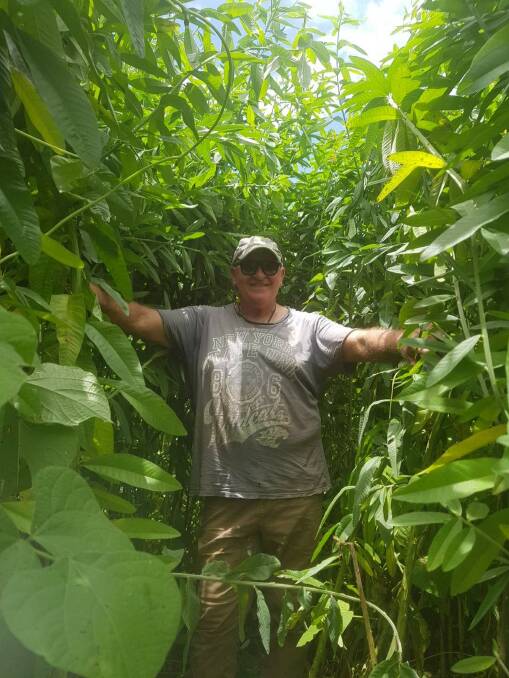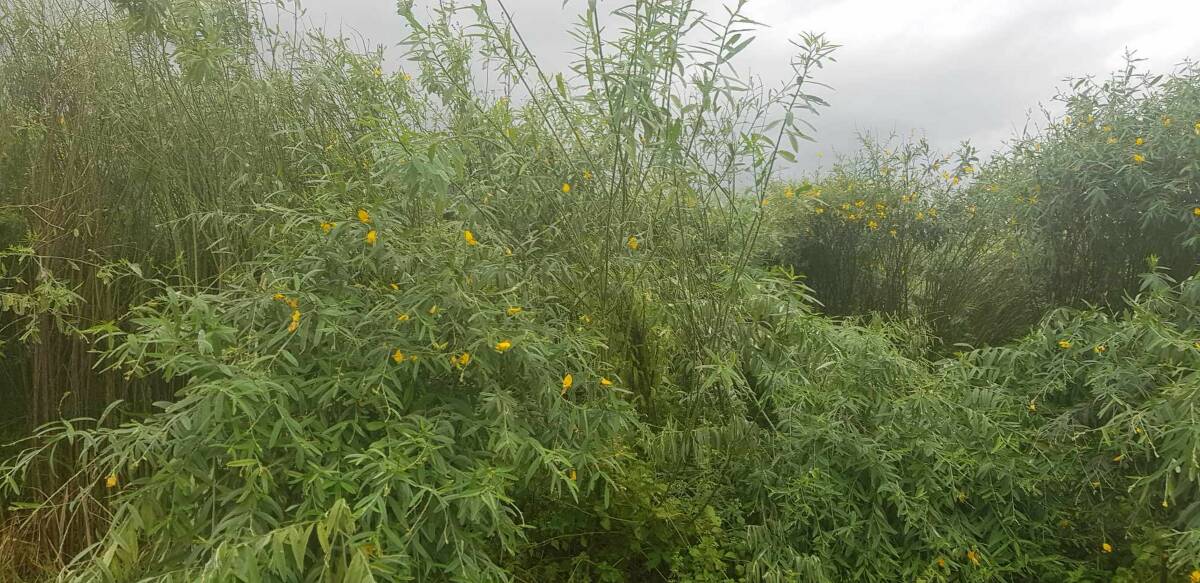FNQ sunn hemp trials show big potential
This is branded content for Department of Agriculture and Fisheries
HAVING a bit of seed leftover from a mixed species cover crop blend has led cane grower Neil Maitland down a research path.
The majority of that seed turned out to be sunn hemp (Crotalaria juncea L.) a legume that has since challenged Mr Maitland's approach to fertiliser use.
The property, operated between the Maitland and Reid families, grows 83 hectares (205 acres) of sugarcane with about 15ha of fallow/rotation ground each year, at Aloomba, south of Cairns.
If we get humidity and rain, it grows at a phenomenal rate.
- Neil Maitland, Aloomba
Mr Maitland himself has been on the property for 43 years to the point where he's confident he's "talked to every stick of cane".
Traditionally, he has always planted a break crop, usually a legume.
After planting a mixed species product one year, some sunn hemp seed remained, so he decided to run it out.
"It was such a small seed, but the crop leapt to 3.5m high," Mr Maitland said.
Driven on by the humidity and high rainfall (Aloomba averages almost 2000mm per year), the crop was so high it prompted Mr Maitland to do some more reading on sunn hemp.
"If we get humidity and rain, it grows at a phenomenal rate," he said.

Sunn hemp is a native plant of Bangladesh, Bhutan and India.
When the plant decomposes, the fixed nitrogen is mineralised and released into the soil and is available for subsequent crops.
It's recommended for rotation with crops prone to root nematode infection such as potatoes and sugarcane due to its resistance and suppressive action against these pests.
Most sunn hemp cultivars grown in Australia require inoculation with rhizobia bacteria to ensure effective nitrogen fixation.
Its vigorous growth rate, particularly in the tropics, sees a crop fully grown in 90 to 120 days.
A welcome input
INITIAL biomass trials at the Aloomba property found the early crop had put some 210kg/ha of nitrogen into the soil. Considering sugarcane in the area requires about 120kg/ha, Mr Maitland was impressed with the results.
Cairns-based Department of Agriculture and Fisheries extension officer, Jack Robertson and Sugar Research Australia researcher, Julian Connellan, then came on board to help conduct various trials on the Maitland property.
Tests showed it boosted the organic carbon in the soil by 0.4 to 0.6 per cent.
Generally, a higher organic carbon level means less additional (synthetic) nitrogen is needed.
Needless to say, the farm has reduced its fertiliser input but maintained its yield.
The farm produced a 144t/ha cane crop last year.
Mr Maitland said he was interested to do some more research to find out how long the organic matter would continue to release nitrogen.
His own experience had been that the woody stalk of the sunn hemp crop breaks down slowly, which could have beneficial impacts on the soil over a longer period of time.

In fact, soil tests after harvesting the cane found the level of organic carbon did not diminish.
The increase in organic matter caused Mr Maitland to notice a visible difference in how easily the soil was worked.
An additional result has been greater water penetration meaning less farm run-off and increased moisture holding capacity; all very good news for reef water quality and the environment as a whole.
The farming families have been ahead of the curve in terms of sustainable land practices.
Mr Maitland said his father-in-law, Ray Hickling, switched to "high floatation" tyres decades ago to lessen compaction and built trailers to suit their controlled traffic operation.
External uses
SUNN hemp can be used as a livestock feed because it is high in protein.
While the fibrous stalk makes it tricky to bale, it is suitable for fodder or silage production.
The plant can also be used for fibre production in the manufacture of twine, cord, canvas, fishing nets, paper and pulp.
In some trials, for every answer you come up with you end up with more questions. And that's the way it should be.
- Neil Maitland, Aloomba
Biodiesel can be produced from the seed due to its oil content, while international work has been done on its pharmaceutical uses.
"In the wet tropics, it is difficult to produce a cash crop through summer," Mr Maitland said.
He said he liked the fact that even if the sunn hemp crop wasn't harvested, it could be ploughed back in for numerous green manure benefits.
"It's a complete win-win, which is very rare in farming," he said.
A sunny future
AUSTRALIA currently imports most of the sunn hemp seed, which can be expensive, according to Mr Maitland.
According to AgriFutures Australia, it is projected that by 2030, the sunn hemp industry could be valued between $2-5 million.
Mr Maitland has encouraged Sugar Research Australia to explore the possibilities for the sugar industry.
He said more scientific evidence would help to drive the sunn hemp industry. Several Far North Queensland farmers are now exploring and experimenting with sunn hemp.
"We all believe there's huge potential in it. It's got a really, really good story to tell," he said.
New ways explored
FROM wanting to know what the leftover seed was in that box years ago, to helping drive a new industry, Mr Maitland said there was always something interesting on the horizon.
"In some trials, for every answer you come up with you end up with more questions. And that's the way it should be," Mr Maitland said.
"Any problem is just an opportunity. Nothing's ever stationary.
"You've got to keep moving into the future because it's the only thing that keeps farming profitable."
To learn about the advantages of Sunn help, watch a video HERE.
To find out about other producers who are using new techniques and innovations to improve practices on-farm in reef catchments, visit qld.gov.au/FarminginReefCatchments or call DAF on 13 25 23.
This is branded content for Department of Agriculture and Fisheries


